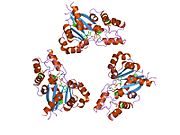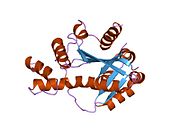| NMNAT1 | |||||||||||||||||||||||||||||||||||||||||||||||||||
|---|---|---|---|---|---|---|---|---|---|---|---|---|---|---|---|---|---|---|---|---|---|---|---|---|---|---|---|---|---|---|---|---|---|---|---|---|---|---|---|---|---|---|---|---|---|---|---|---|---|---|---|
 | |||||||||||||||||||||||||||||||||||||||||||||||||||
| |||||||||||||||||||||||||||||||||||||||||||||||||||
| Identifiers | |||||||||||||||||||||||||||||||||||||||||||||||||||
| Aliases | NMNAT1, LCA9, NMNAT, PNAT1, nicotinamide nucleotide adenylyltransferase 1, SHILCA | ||||||||||||||||||||||||||||||||||||||||||||||||||
| External IDs | OMIM: 608700; MGI: 1913704; HomoloGene: 39074; GeneCards: NMNAT1; OMA:NMNAT1 - orthologs | ||||||||||||||||||||||||||||||||||||||||||||||||||
| |||||||||||||||||||||||||||||||||||||||||||||||||||
| |||||||||||||||||||||||||||||||||||||||||||||||||||
| |||||||||||||||||||||||||||||||||||||||||||||||||||
| |||||||||||||||||||||||||||||||||||||||||||||||||||
| Wikidata | |||||||||||||||||||||||||||||||||||||||||||||||||||
| |||||||||||||||||||||||||||||||||||||||||||||||||||
Nicotinamide mononucleotide adenylyltransferase 1 (NMNAT1) is an enzyme that in humans is encoded by the nmnat1 gene. It is a member of the nicotinamide-nucleotide adenylyltransferases (NMNATs) which catalyze nicotinamide adenine dinucleotide (NAD) synthesis.
Function
The coenzyme NAD and its derivatives are involved in hundreds of metabolic redox reactions and are utilized in protein ADP-ribosylation, histone deacetylation, and in some Ca signaling pathways. NMNAT (EC 2.7.7.1) is a central enzyme in NAD biosynthesis, catalyzing the condensation of nicotinamide mononucleotide (NMN) or nicotinic acid mononucleotide (NaMN) with the AMP moiety of ATP to form NAD or NaAD.
NMNAT1 is the most widely expressed of three orthologous genes with nicotinamide-nucleotide adenylyltransferase (NMNAT) activity. Genetically engineered mice lacking NMNAT1 die during early embryogenesis, indicating a critical role of this gene in organismal viability. In contrast, mice lacking NMNAT2, which is expressed predominantly in neural tissues, complete development but die shortly after birth. However, NMNAT1 is dispensable for cell viability, as homozygous deletion of this gene occurs in glioblastoma tumors and cell lines. Other tumors such as osteosarcoma, however, increase the expression of NMNAT1 upon exposure to DNA damaging agents and inactivation of the nmnat1 gene renders these cells more sensitive to chemotherapy with cisplatin. This latter effect involves lowered nuclear NAD levels in NMNAT1 knockout cells and impaired DNA damage sensing by the NAD-dependent DNA break responsive enzyme poly (ADP-ribose) polymerase-1 (PARP1). The dependence of osteosarcoma cells on NMNAT1-derived NAD for the PARP1-dependent DNA repair and survival is not restricted to cisplatin-treated cancer cells but has also been reported to occur in actinomycine D-treated tumor cell lines, as well. These data suggest that nuclear NAD synthesis by NMNAT1 may represent a therapeutic target in osteosarcoma and possibly in other tumors, as well.
NMNAT enzymatic activity is probably essential at the cellular level, as complete ablation of NMNAT activity in model organisms leads to cellular inviability.
NMNAT1 enhancement opposes the actions of SARM1 which would lead to axon degeneration, but this effect is not due to preventing SARM1 depletion of NAD+.
Clinical relevance
Mutations in this gene have been shown associated to the LCA9 form of the retinal degeneration pathology Leber's congenital amaurosis.
Aging
Aged mice show a significant reduction of NMNAT1 gene products in the liver (which is the main site of de novo synthesis of NAD+). All NMNAT gene isoform products also decline with age in mice in kidneys, oocytes, and colons.
References
- ^ GRCh38: Ensembl release 89: ENSG00000173614 – Ensembl, May 2017
- ^ GRCm38: Ensembl release 89: ENSMUSG00000028992 – Ensembl, May 2017
- "Human PubMed Reference:". National Center for Biotechnology Information, U.S. National Library of Medicine.
- "Mouse PubMed Reference:". National Center for Biotechnology Information, U.S. National Library of Medicine.
- Schweiger M, Hennig K, Lerner F, Niere M, Hirsch-Kauffmann M, Specht T, Weise C, Oei SL, Ziegler M (Mar 2001). "Characterization of recombinant human nicotinamide mononucleotide adenylyl transferase (NMNAT), a nuclear enzyme essential for NAD synthesis". FEBS Lett. 492 (1–2): 95–100. doi:10.1016/S0014-5793(01)02180-9. PMID 11248244.
- Emanuelli M, Carnevali F, Saccucci F, Pierella F, Amici A, Raffaelli N, Magni G (Feb 2001). "Molecular cloning, chromosomal localization, tissue mRNA levels, bacterial expression, and enzymatic properties of human NMN adenylyltransferase". J Biol Chem. 276 (1): 406–12. doi:10.1074/jbc.M008700200. PMID 11027696.
- ^ "Entrez Gene: NMNAT1 nicotinamide nucleotide adenylyltransferase 1".
- ^ Brazill JM, Li C, Zhu Y, Zhai RG (2017). "NMNAT: It's an NAD + Synthase… It's a Chaperone… It's a Neuroprotector". Current Opinion in Genetics & Development. 44: 156–162. doi:10.1016/j.gde.2017.03.014. PMC 5515290. PMID 28445802.
- Fletcher RS, Lavery GG (2018). "The emergence of the nicotinamide riboside kinases in the regulation of NAD+ metabolism". Journal of Molecular Endocrinology. 61 (3): R107 – R121. doi:10.1530/JME-18-0085. PMC 6145238. PMID 30307159.
- ^ Kiss, Alexandra; Ráduly, Arnold Péter; Regdon, Zsolt; Polgár, Zsuzsanna; Tarapcsák, Szabolcs; Sturniolo, Isotta; El-Hamoly, Tarek; Virág, László; Hegedűs, Csaba (2020-05-07). "Targeting Nuclear NAD+ Synthesis Inhibits DNA Repair, Impairs Metabolic Adaptation and Increases Chemosensitivity of U-2OS Osteosarcoma Cells". Cancers. 12 (5): E1180. doi:10.3390/cancers12051180. ISSN 2072-6694. PMC 7281559. PMID 32392755.
- ^ Kiss, Alexandra; Csikos, Csaba; Regdon, Zsolt; Polgár, Zsuzsanna; Virág, László; Hegedűs, Csaba (2021-08-18). "NMNAT1 Is a Survival Factor in Actinomycin D-Induced Osteosarcoma Cell Death". International Journal of Molecular Sciences. 22 (16): 8869. doi:10.3390/ijms22168869. ISSN 1422-0067. PMC 8396190. PMID 34445574.
- Muller FL, Colla S, Aquilanti E, et al. (August 2012). "Passenger deletions generate therapeutic vulnerabilities in cancer". Nature. 488 (7411): 337–42. Bibcode:2012Natur.488..337M. doi:10.1038/nature11331. PMC 3712624. PMID 22895339.
- Sasaki Y, Nakagawa T, Mao X, DiAntonio A, Milbrandt J (October 2016). "+ depletion". eLife. 5. doi:10.7554/eLife.19749. PMC 5063586. PMID 27735788.
- Koenekoop RK, Wang H, Majewski J, Wang X, Lopez I, Ren H, Chen Y, Li Y, Fishman GA, Genead M, Schwartzentruber J, Solanki N, Traboulsi EI, Cheng J, Logan CV, McKibbin M, Hayward BE, Parry DA, Johnson CA, Nageeb M, Poulter JA, Mohamed MD, Jafri H, Rashid Y, Taylor GR, Keser V, Mardon G, Xu H, Inglehearn CF, Fu Q, Toomes C, Chen R (September 2012). "Mutations in NMNAT1 cause Leber congenital amaurosis and identify a new disease pathway for retinal degeneration". Nat. Genet. 44 (9). Finding of Rare Disease Genes (FORGE) Canada Consortium: 1035–9. doi:10.1038/ng.2356. PMC 3657614. PMID 22842230.
- Jadeja RN, Thounaojam MC, Martin PM (2020). "Implications of NAD + Metabolism in the Aging Retina and Retinal Degeneration". Oxidative Medicine and Cellular Longevity. 2020: 2692794. doi:10.1155/2020/2692794. PMC 7238357. PMID 32454935.
- ^ McReynolds MR, Chellappa K, Baur JA (2020). "Age-related NAD + decline". Experimental Gerontology. 134: 110888. doi:10.1016/j.exger.2020.110888. PMC 7442590. PMID 32097708.
Further reading
- Maruyama K, Sugano S (1994). "Oligo-capping: a simple method to replace the cap structure of eukaryotic mRNAs with oligoribonucleotides". Gene. 138 (1–2): 171–4. doi:10.1016/0378-1119(94)90802-8. PMID 8125298.
- Garavaglia S, D'Angelo I, Emanuelli M, et al. (2002). "Structure of human NMN adenylyltransferase. A key nuclear enzyme for NAD homeostasis". J. Biol. Chem. 277 (10): 8524–30. doi:10.1074/jbc.M111589200. PMID 11751893.
- Werner E, Ziegler M, Lerner F, et al. (2002). "Crystallization and preliminary X-ray analysis of human nicotinamide mononucleotide adenylyltransferase (NMNAT)". Acta Crystallogr. D. 58 (Pt 1): 140–2. Bibcode:2002AcCrD..58..140W. doi:10.1107/S0907444901017437. PMID 11752792.
- Zhou T, Kurnasov O, Tomchick DR, et al. (2002). "Structure of human nicotinamide/nicotinic acid mononucleotide adenylyltransferase. Basis for the dual substrate specificity and activation of the oncolytic agent tiazofurin". J. Biol. Chem. 277 (15): 13148–54. doi:10.1074/jbc.M111469200. PMID 11788603.
- Fernando FS, Conforti L, Tosi S, et al. (2002). "Human homologue of a gene mutated in the slow Wallerian degeneration (C57BL/Wld(s)) mouse". Gene. 284 (1–2): 23–9. doi:10.1016/S0378-1119(02)00394-3. PMID 11891043.
- Werner E, Ziegler M, Lerner F, et al. (2002). "Crystal structure of human nicotinamide mononucleotide adenylyltransferase in complex with NMN". FEBS Lett. 516 (1–3): 239–44. doi:10.1016/S0014-5793(02)02556-5. PMID 11959140.
- Raffaelli N, Sorci L, Amici A, et al. (2002). "Identification of a novel human nicotinamide mononucleotide adenylyltransferase". Biochem. Biophys. Res. Commun. 297 (4): 835–40. doi:10.1016/S0006-291X(02)02285-4. PMID 12359228.
- Zhang X, Kurnasov OV, Karthikeyan S, et al. (2003). "Structural characterization of a human cytosolic NMN/NaMN adenylyltransferase and implication in human NAD biosynthesis". J. Biol. Chem. 278 (15): 13503–11. doi:10.1074/jbc.M300073200. PMID 12574164.
- Yalowitz JA, Xiao S, Biju MP, et al. (2004). "Characterization of human brain nicotinamide 5'-mononucleotide adenylyltransferase-2 and expression in human pancreas". Biochem. J. 377 (Pt 2): 317–26. doi:10.1042/BJ20030518. PMC 1223862. PMID 14516279.
- Suzuki Y, Yamashita R, Shirota M, et al. (2004). "Sequence comparison of human and mouse genes reveals a homologous block structure in the promoter regions". Genome Res. 14 (9): 1711–8. doi:10.1101/gr.2435604. PMC 515316. PMID 15342556.
- Berger F, Lau C, Dahlmann M, Ziegler M (2006). "Subcellular compartmentation and differential catalytic properties of the three human nicotinamide mononucleotide adenylyltransferase isoforms". J. Biol. Chem. 280 (43): 36334–41. doi:10.1074/jbc.M508660200. PMID 16118205.
- Olsen JV, Blagoev B, Gnad F, et al. (2006). "Global, in vivo, and site-specific phosphorylation dynamics in signaling networks". Cell. 127 (3): 635–48. doi:10.1016/j.cell.2006.09.026. PMID 17081983. S2CID 7827573.
- Berger F, Lau C, Ziegler M (2007). "Regulation of poly(ADP-ribose) polymerase 1 activity by the phosphorylation state of the nuclear NAD biosynthetic enzyme NMN adenylyl transferase 1". Proc. Natl. Acad. Sci. U.S.A. 104 (10): 3765–70. Bibcode:2007PNAS..104.3765B. doi:10.1073/pnas.0609211104. PMC 1820658. PMID 17360427.








